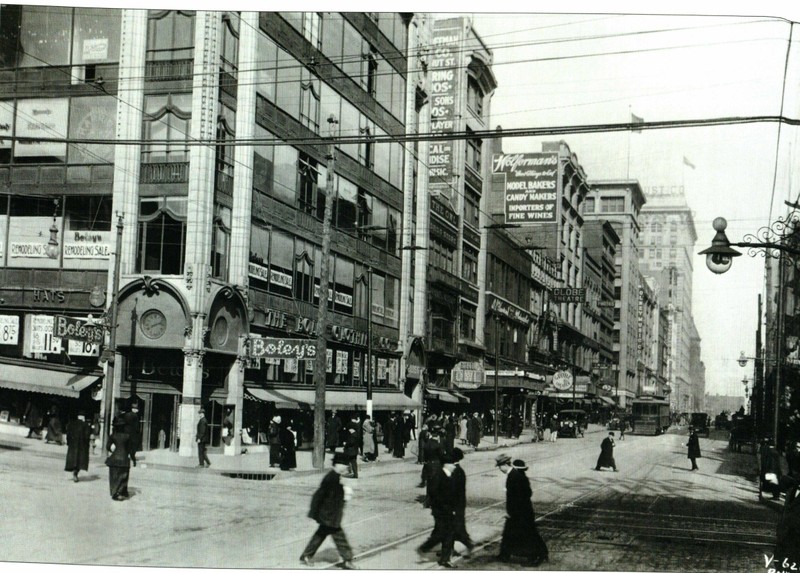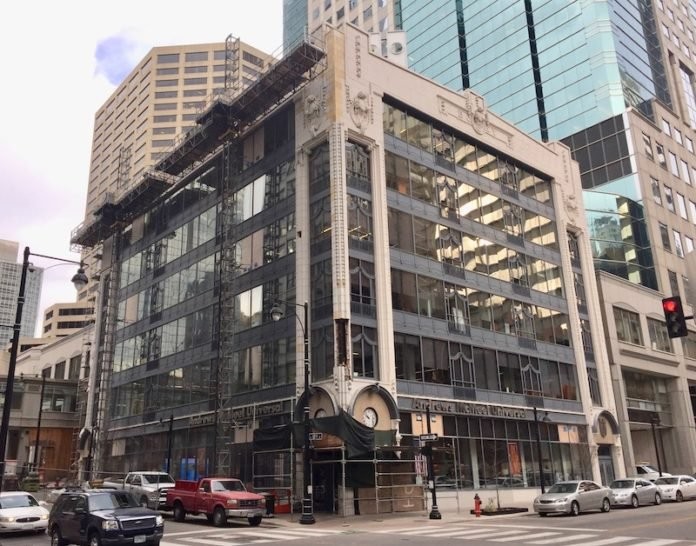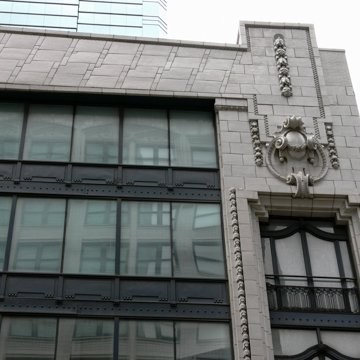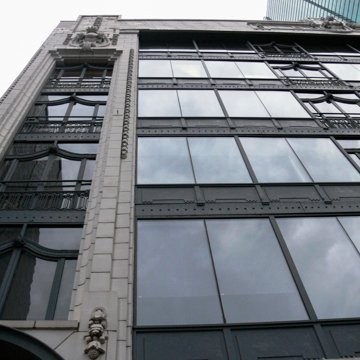Boley Building (aka Katz Building)
Introduction
Text-to-speech Audio
The Boley Building is a six-story, steel-frame Art Nouveau commercial building constructed in 1909 by noted architect Louis Curtiss. The building's National Register of Historic Places (NRHP) nomination form called it Curtiss' "single most important work."
Originally occupied by clothing store Charles N. Boley, the building may have been the very first "curtain wall" metal and glass structure in America, as it was constructed almost a decade earlier than San Francisco's Hallidie Building, which is sometimes considered the first "curtain wall" design. It was not well received in its day, but this design concept would become popular beginning in the 1950s. Thus, the building was at least 40 years ahead of its time.
The building is also known as the Katz Building, because the Katz Drug Company owned the building for a time. It is now the headquarters of Andrews McMeel Universal, a publisher of noteworthy comics and books including "Calvin and Hobbes" and "Doonesbury." It was included in the NRHP in March, 1971.
Images
The Boley Building (circa 1910)

Exterior view of The Boley Building (today)

Exterior of The Boley Building (detail)

Exterior of The Boley Building (detail)

Backstory and Context
Text-to-speech Audio
Louis Curtiss, who was born in Canada and who spent almost his entire adult life in Kansas City (he died in 1924 at 58), was nevertheless, according to the Boley Building's NRHP nomination form, a "nationally important" architect. Curtiss, called the "Frank Lloyd Wright of Kansas City," was a very mysterious and eccentric figure. He was said to have studied design at the University of Toronto and the Ecole des Beaux-Arts in Paris, yet no records of his having attended either institution now exist. Curtiss arrived in Kansas City in 1887 and two years later started a partnership with architect Frederick C. Gunn, finally striking out on his own about a decade later. His early work reveals a classical influence, but beginning in the early 20th Century, he began to evolve a more contemporary style.
The Boley Building is considered Curtiss' most significant achievement for several reasons: 1) it was one of the first "curtain wall" buildings in the world, that is, it consists of a steel frame enclosed in flat planes of glass, as the walls hang upon the structure, rather than support it; 2) it is composed of solid steel columns rolled in one piece ("rolled columns"), rather than steel plates riveted together; 3) it is built entirely on caissons, with 92 caissons of approximately 37 feet each that are used as the building's foundation; and 4) it employs experimental suspended building structures. This last signifies that not only the facade, but also the entire floor structure for the bays directly behind the facade, are suspended by one-and-a-half foot square steel hangers from a forty-two foot plate girder at the roof line. It has round-arched entrances at the ends of its two facades, as well as white terra-cotta framing with Art Nouveau detailing.
The design was not well-received at the time, with some commentators considering it stark and barren. But curtain walls allow a great deal of sunlight to flood the interior of a building, and this fact made the design popular from the 1950s onward. However, by that time, Curtiss had long since died.
The building is now the headquarters of Andrews McMeel Universal (AMU), a media company founded by Jim Andrews and John McMeel in 1970 as Universal Press Syndicate. The partners achieved their first real success serializing Garry Trudeau's classic comic strip Doonesbury, though 40 newspapers had already turned down Trudeau's work. They also syndicated the strip Cathy, about a single working woman, by Cathy Guisewite, one of the first highly successful strips written by a woman cartoonist. By the 1980s, AMU had signed some of the most popular cartoonists in the United States, and was ranked as the syndicate with the highest success rate with comics, according to Cartoonist Profiles magazine.
To accommodate its hundreds of employees, AMU completely renovated the Boley Building, incorporating the abandoned post-modern food court in the adjacent town center office building. The new interior, which takes full advantage of the plentiful sunlight provided by Curtiss' design, includes a multi-story grand stair, expansive skylights and a ground floor café. In this way, it "resonates with the energy of a company looking to the future while respecting its past."
The Boley Building is considered Curtiss' most significant achievement for several reasons: 1) it was one of the first "curtain wall" buildings in the world, that is, it consists of a steel frame enclosed in flat planes of glass, as the walls hang upon the structure, rather than support it; 2) it is composed of solid steel columns rolled in one piece ("rolled columns"), rather than steel plates riveted together; 3) it is built entirely on caissons, with 92 caissons of approximately 37 feet each that are used as the building's foundation; and 4) it employs experimental suspended building structures. This last signifies that not only the facade, but also the entire floor structure for the bays directly behind the facade, are suspended by one-and-a-half foot square steel hangers from a forty-two foot plate girder at the roof line. It has round-arched entrances at the ends of its two facades, as well as white terra-cotta framing with Art Nouveau detailing.
The design was not well-received at the time, with some commentators considering it stark and barren. But curtain walls allow a great deal of sunlight to flood the interior of a building, and this fact made the design popular from the 1950s onward. However, by that time, Curtiss had long since died.
The building is now the headquarters of Andrews McMeel Universal (AMU), a media company founded by Jim Andrews and John McMeel in 1970 as Universal Press Syndicate. The partners achieved their first real success serializing Garry Trudeau's classic comic strip Doonesbury, though 40 newspapers had already turned down Trudeau's work. They also syndicated the strip Cathy, about a single working woman, by Cathy Guisewite, one of the first highly successful strips written by a woman cartoonist. By the 1980s, AMU had signed some of the most popular cartoonists in the United States, and was ranked as the syndicate with the highest success rate with comics, according to Cartoonist Profiles magazine.
To accommodate its hundreds of employees, AMU completely renovated the Boley Building, incorporating the abandoned post-modern food court in the adjacent town center office building. The new interior, which takes full advantage of the plentiful sunlight provided by Curtiss' design, includes a multi-story grand stair, expansive skylights and a ground floor café. In this way, it "resonates with the energy of a company looking to the future while respecting its past."
Sources
Hannah, Sheila. "Boley Building (aka Katz Building)." National Register of Historic Places Inventory - Nomination Form. US Department of the Interior, National Park Service. Publication Date: 7/23/70. Access Date: 5/5/19. https://dnr.mo.gov/shpo/nps-nr/71000467.pdf.
Roe, Jason. "The Frank Lloyd Wright of Kansas City." KC History (Kansas City Public Library). Access Date: 5/5/19. http://www.kchistory.org/week-kansas-city-history/frank-lloyd-wright-kansas-city.
"Boley Building." SAH Archipedia (Society of Architectural Historians). Access Date: 5/5/19. https://sah-archipedia.org/buildings/MO-01-095-0001.
Vogler, Adam. "Andrews McMeel's historic HQ reflects the company's mission." Kansas City Business Journal. Publication Date: 2/23/18. Access Date: 5/5/19. https://www.bizjournals.com/kansascity/news/2018/02/23/andrews-mcmeel-headquarters-photo-tour.html.
Vogler, Adam. "Andrews McMeel's historic HQ reflects the company's mission." Kansas City Business Journal. Publication Date: 2/23/18. Access Date: 5/5/19. https://www.bizjournals.com/kansascity/news/2018/02/23/andrews-mcmeel-headquarters-photo-tour.html.
"Who We Are." Andrews McMeel Universal. Access Date: 5/5/19. https://www.andrewsmcmeel.com/about.
"Andrews McMeel Universal History." Funding Universe. Access Date: 5/5/19. http://www.fundinguniverse.com/company-histories/andrews-mcmeel-universal-history.
"History of the Boley Building." Helix. Access Date: 5/5/19. https://helixkc.com/history-boley-building.
